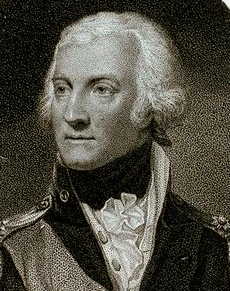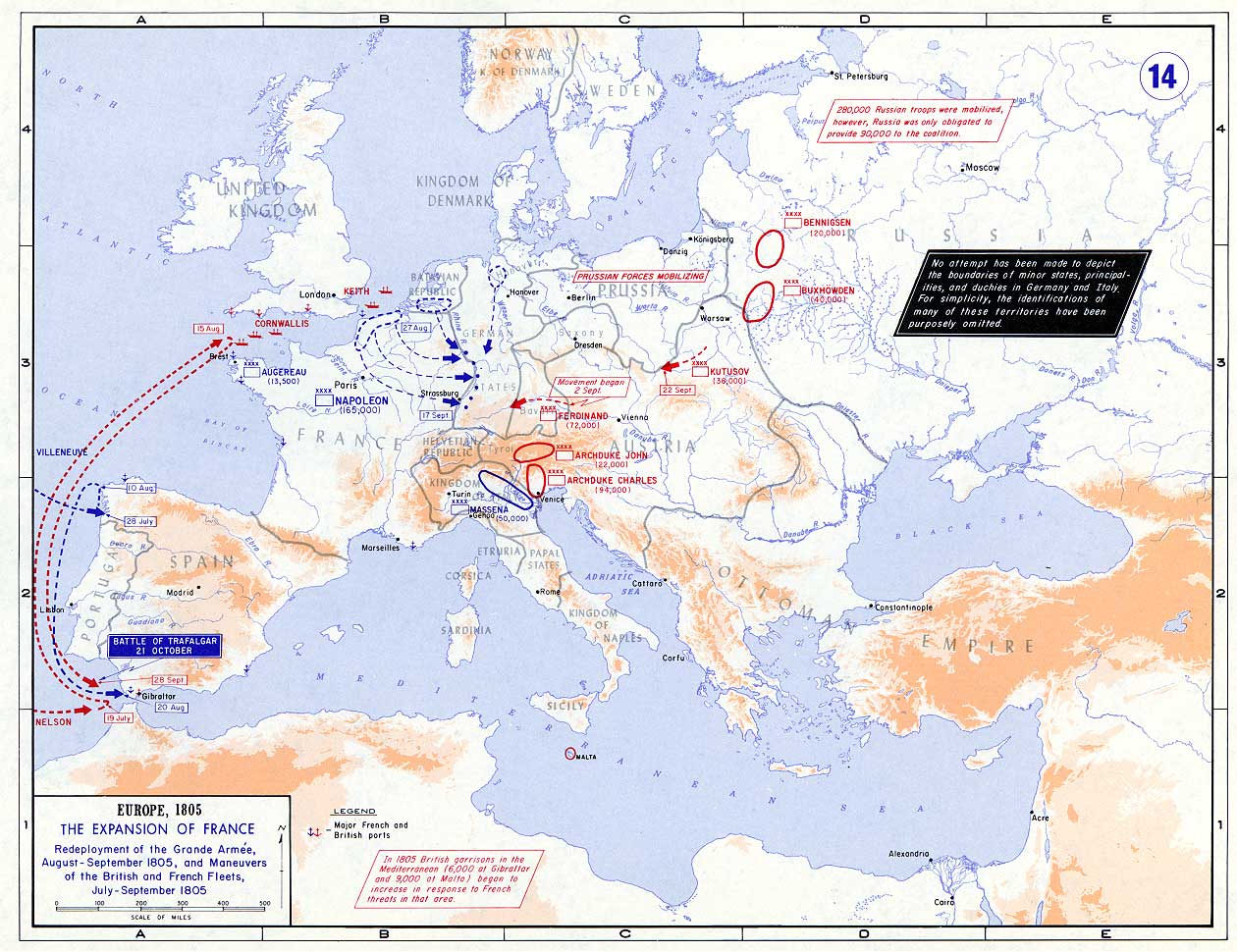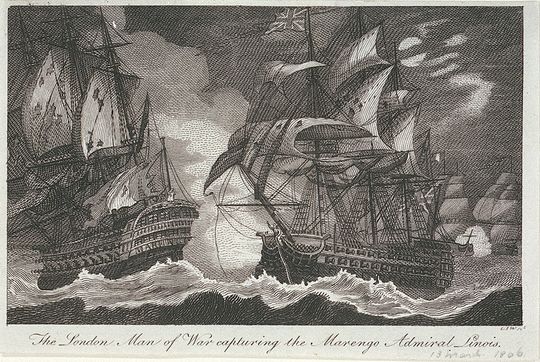|
Action Of 13 March 1806
The action of 13 March 1806 was a naval engagement of the Napoleonic Wars, fought when a British and a French squadron met unexpectedly in the mid-Atlantic. Neither force was aware of the presence of the other prior to the encounter and were participating in separate campaigns. The British squadron consisted of seven ships of the line accompanied by associated frigates, led by Rear-Admiral Sir John Borlase Warren, were tasked with hunting down and destroying the French squadron of Contre-Admiral Jean-Baptiste Willaumez, which had departed Brest for raiding operations in the South Atlantic in December 1805, at the start of the Atlantic campaign of 1806. The French force consisted of one ship of the line and one frigate, all that remained of Contre-Admiral Charles-Alexandre Durand Linois' squadron that had sailed for the Indian Ocean in March 1803 during the Peace of Amiens. Linois raided British shipping lanes and harbours across the region, achieving limited success against ... [...More Info...] [...Related Items...] OR: [Wikipedia] [Google] [Baidu] |
War Of The Third Coalition
The War of the Third Coalition () was a European conflict lasting from 1805 to 1806 and was the first conflict of the Napoleonic Wars. During the war, First French Empire, France and French client republic, its client states under Napoleon I and its ally Spain opposed an alliance, the Third Coalition, which was made up of the United Kingdom of Great Britain and Ireland, United Kingdom, the Austrian Empire, the Russian Empire, Kingdom of Naples, Naples, Kingdom of Sicily, Sicily, and Sweden. Kingdom of Prussia, Prussia remained neutral during the war. Britain had already been at war with France following the breakdown of the Treaty of Amiens, Peace of Amiens and remained the only country still at war with France after the Treaty of Pressburg (1805), Treaty of Pressburg. From 1803 to 1805, Britain stood under constant threat of a Napoleon's planned invasion of the United Kingdom, French invasion. The Royal Navy, however, assured its naval dominance at the Battle of Trafalgar in Oc ... [...More Info...] [...Related Items...] OR: [Wikipedia] [Google] [Baidu] |
French Ship Jean-Jacques Rousseau (1795)
''Jean-Jacques Rousseau'' was a 74-gun ship of the line of the French Navy, active during the French Directory, French Consulate and First French Empire. Renamed ''Marengo'' in 1802, she took part in Linois' operations in the Indian Ocean before her capture by the Royal Navy. Career Construction of ''Jean-Jacques Rousseau'' began in September 1794 at Toulon, and she was launched on 21 July 1795. In October 1796, under Captain Racord, she was part of the Villeneuve's squadron that sailed from Toulon to Brest. On 2 December 1802, she was renamed to ''Marengo'', reflecting the political change away from the Revolutionary Republic inspired by Jean-Jacques Rousseau towards the advent of General Bonaparte. On 6 March 1803, she departed Brest as the flagship of a squadron under Admiral Linois, set to take possession of Pondicherry, which the Treaty of Amiens had attributed to France. The squadron also comprised the frigates ''Belle Poule'', ''Atalante'' and ''Sémillante'', al ... [...More Info...] [...Related Items...] OR: [Wikipedia] [Google] [Baidu] |
Guangzhou
Guangzhou, Chinese postal romanization, previously romanized as Canton or Kwangchow, is the Capital city, capital and largest city of Guangdong Provinces of China, province in South China, southern China. Located on the Pearl River about northwest of Hong Kong and north of Macau, Guangzhou has a history of over 2,200 years and was a major terminus of the Silk Road. The port of Guangzhou serves as a transportation hub for China's fourth largest city and surrounding areas, including Hong Kong. Guangzhou was captured by the United Kingdom, British during the First Opium War and no longer enjoyed a monopoly after the war; consequently it lost trade to other ports such as Hong Kong and Shanghai, but continued to serve as a major entrepôt. Following the Second Battle of Chuenpi in 1841, the Treaty of Nanking was signed between Robert Peel, Sir Robert Peel on behalf of Queen Victoria and Lin Zexu on behalf of Daoguang Emperor, Emperor Xuanzong and ceded British Hong Kong, Hong Kon ... [...More Info...] [...Related Items...] OR: [Wikipedia] [Google] [Baidu] |
South China Sea
The South China Sea is a marginal sea of the Western Pacific Ocean. It is bounded in the north by South China, in the west by the Indochinese Peninsula, in the east by the islands of Taiwan island, Taiwan and northwestern Philippines (mainly Luzon, Mindoro and Palawan Island, Palawan), and in the south by Borneo, eastern Sumatra and the Bangka Belitung Islands, encompassing an area of around . It communicates with the East China Sea via the Taiwan Strait, the Philippine Sea via the Luzon Strait, the Sulu Sea via the straits around Palawan, the Java Sea via the Karimata Strait, Karimata and Bangka Straits and directly with Gulf of Thailand. The Gulf of Tonkin is part of the South China Sea. $3.4 trillion of the world's $16 trillion Maritime transport, maritime shipping passed through South China Sea in 2016. Oil and natural gas reserves have been found in the area. The Western Central Pacific accounted for 14% of world's commercial fishing in 2010. The South China Sea Islands, ... [...More Info...] [...Related Items...] OR: [Wikipedia] [Google] [Baidu] |
India
India, officially the Republic of India, is a country in South Asia. It is the List of countries and dependencies by area, seventh-largest country by area; the List of countries by population (United Nations), most populous country since 2023; and, since its independence in 1947, the world's most populous democracy. Bounded by the Indian Ocean on the south, the Arabian Sea on the southwest, and the Bay of Bengal on the southeast, it shares land borders with Pakistan to the west; China, Nepal, and Bhutan to the north; and Bangladesh and Myanmar to the east. In the Indian Ocean, India is near Sri Lanka and the Maldives; its Andaman and Nicobar Islands share a maritime border with Thailand, Myanmar, and Indonesia. Modern humans arrived on the Indian subcontinent from Africa no later than 55,000 years ago., "Y-Chromosome and Mt-DNA data support the colonization of South Asia by modern humans originating in Africa. ... Coalescence dates for most non-European populations averag ... [...More Info...] [...Related Items...] OR: [Wikipedia] [Google] [Baidu] |
Prisoner Exchange
A prisoner exchange or prisoner swap is a deal between opposing sides in a conflict to release prisoners: prisoner of war, prisoners of war, spy, spies, hostages, etc. Sometimes, cadaver, dead bodies are involved in an exchange. Geneva Conventions Under the Geneva Conventions, prisoners who ''cannot'' contribute to the war effort because of Wounded in action, illness or disability are entitled to be repatriated to their home country. That is regardless of number of prisoners so affected; the detaining power cannot refuse a genuine request. Under the Geneva Convention on Prisoners of War (1929), Geneva Convention (1929), this is covered by Articles 68 to 74, and the annex. One of the largest exchange programmes was run by the International Committee of the Red Cross, International Red Cross during World War II under these terms. Under the Third Geneva Convention of 1949, that is covered by Articles 109 to 117. The World War II in Yugoslavia, Second World War in Yugoslavia saw ... [...More Info...] [...Related Items...] OR: [Wikipedia] [Google] [Baidu] |
Prisoner Of War
A prisoner of war (POW) is a person held captive by a belligerent power during or immediately after an armed conflict. The earliest recorded usage of the phrase "prisoner of war" dates back to 1610. Belligerents hold prisoners of war for a range of legitimate and illegitimate reasons. These may include isolating them from enemy combatants still in the field (releasing and Repatriation, repatriating them in an orderly manner after hostilities), demonstrating military victory, punishment, prosecution of war crimes, labour exploitation, recruiting or even conscripting them as combatants, extracting collecting military and political intelligence, and political or religious indoctrination. Ancient times For much of history, prisoners of war would often be slaughtered or enslaved. Early Roman gladiators could be prisoners of war, categorised according to their ethnic roots as Samnites, Thracians, and Gauls (''Galli''). Homer's ''Iliad'' describes Trojan and Greek soldiers offeri ... [...More Info...] [...Related Items...] OR: [Wikipedia] [Google] [Baidu] |
Gale
A gale is a strong wind; the word is typically used as a descriptor in nautical contexts. The U.S. National Weather Service defines a gale as sustained surface wind moving at a speed between .National Weather Service Glossary s.v "gale" Forecasters typically issue s when winds of this strength are expected. In the , a gale warning is specifically a maritime warning; the land-based equivalent in National Weather Service ... [...More Info...] [...Related Items...] OR: [Wikipedia] [Google] [Baidu] |
Battle Of San Domingo
The Battle of San Domingo was a naval battle of the War of the Third Coalition fought on 6 February 1806 between squadrons of First French Empire, French and United Kingdom of Great Britain and Ireland, British ships of the line off the southern coast of the French-occupied Captaincy General of Santo Domingo (''San Domingo'' in contemporary English-language accounts) in the Caribbean. All five of the French ships of the line commanded by Counter-admiral Corentin Urbain de Leissègues were captured or destroyed. The Royal Navy led by Vice-admiral John Thomas Duckworth, Sir John Thomas Duckworth lost no ships and suffered fewer than a hundred killed while the French lost approximately 1,500 men. Only a small number of the French squadron were able to escape. The battle was the last major engagement of the French Revolutionary and Napoleonic Wars between British and French ships of the line in open water. Background In late 1805, First Lord of the Admiralty Charles Middleton, 1st ... [...More Info...] [...Related Items...] OR: [Wikipedia] [Google] [Baidu] |
HMS Amazon (1799)
HMS ''Amazon'' was a 38-gun fifth-rate Amazon-class frigate (1799), ''Amazon''-class frigate of the Royal Navy. She served during the French Revolutionary Wars, French Revolutionary and Napoleonic Wars under several notable naval commanders and played a key role in the Battle of Copenhagen (1801), Battle of Copenhagen under Edward Riou, who commanded the frigate squadron (naval), squadron during the attack. After Riou was killed during the battle, command briefly devolved to John Quilliam. Quilliam made a significant impression on Horatio Nelson, 1st Viscount Nelson, Horatio Nelson, who appointed Quilliam to serve on the flagship . ''Amazon'' passed to Sir William Parker, 1st Baronet, of Shenstone, William Parker, who continued the association with Nelson with service in the Mediterranean and participation in the chase to the West Indies during the Trafalgar Campaign. ''Amazon'' went on to join Sir John Borlase Warren, 1st Baronet, Sir John Borlase Warren's squadron in the Atlan ... [...More Info...] [...Related Items...] OR: [Wikipedia] [Google] [Baidu] |
French Frigate Belle Poule (1802)
HMS ''Belle Poule'' was a Royal Navy fifth-rate frigate, formerly ''Belle Poule'', a of the French Navy that had been built by the Crucy family's shipyard at Basse-Indre to a design by Jacques-Noël Sané. She was launched on 17 April 1802, and saw active service in the East. In 1806 a British squadron under Sir John Borlase Warren captured her off La Palma in the Canary Islands. The Admiralty commissioned her into the Royal Navy as HMS ''Belle Poule''. She was sold in 1816. French Navy service In March 1803, she joined the fleet of Rear-Admiral Charles-Alexandre Léon Durand Linois, whose mission was to re-take the colonies of the Indian Ocean, given to English at the peace of Amiens. The fleet included the 74-gun ship of the line ''Marengo'', the frigates , ''Belle Poule'' and , troop ships, and transports with food and ammunition. On 15 June 1803 ''Belle Poule'' landed troops at Pondichéry in India. However, the French fleet left the next day and the troops surrender ... [...More Info...] [...Related Items...] OR: [Wikipedia] [Google] [Baidu] |







